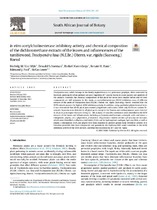In vitro acetylcholinesterase inhibitory activity and chemical composition of the dichloromethane extracts of the leaves and inflorescences of the tumbleweed, Trachyandra laxa (N.E.Br.) Oberm. var. rigida (Suesseng.) Roessl
Abstract
Trachyandra laxa, which belongs to the family Asphodelaceae, is a poisonous geophyte, often consumed by
livestock, particularly when pastures are poor. Ingestion of T. laxa by livestock causes paresis and paralysis of
the animals. However, the chemical composition of this plant has never been studied before and its toxic
components are still unknown. In this study, an acetylcholinesterase (AChE) inhibition assay of different
extracts of the parts of Trachyandra laxa (N.E.Br.) Oberm. var. rigida (Suesseng.) Roessl. revealed that the
DCM extracts possess the highest AChE inhibitory activity. In addition, using qualitative phytochemical tests,
it was determined that all the plant parts contain polyphenols and tannins, while only the leaves contain flavonoids.
Saponins were detected in all plant parts, except in the flowers and anthraquinones were detected
in all plant parts expect the roots. Using GC MS analysis, 13 volatile constituents were identified in the DCM
extracts of the leaves and inflorescences, including a,b-unsaturated lactones, carboxylic acids and esters, a
diterpenoid, phytol, and a phytosterol, b-sitosterol. Of particular interest are the a,b-unsaturated lactones,
which were identified as dihydroactinidiolide (DHA) and its hydroxylated analogue, hydroxy‑DHA, as well as
phytol, a diterpenoid. DHA and phytol have been reported to possess potent AChE inhibition activity. It is
therefore plausible that these compounds and potentially also hydroxy‑DHA could contribute to the AChE
inhibitory activity of the DCM extracts, and thus the neurotoxicity of T. laxa var. rigida.

